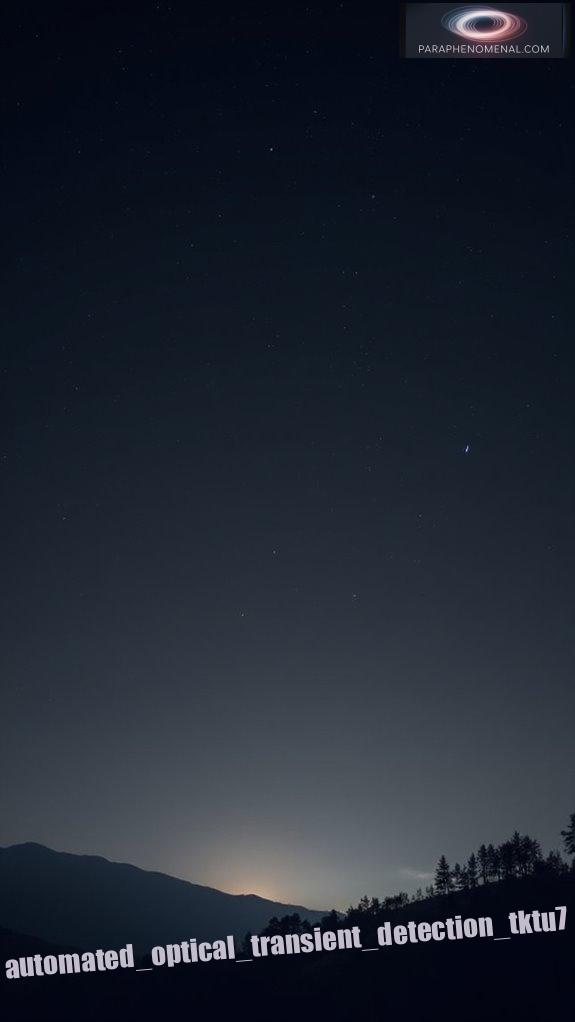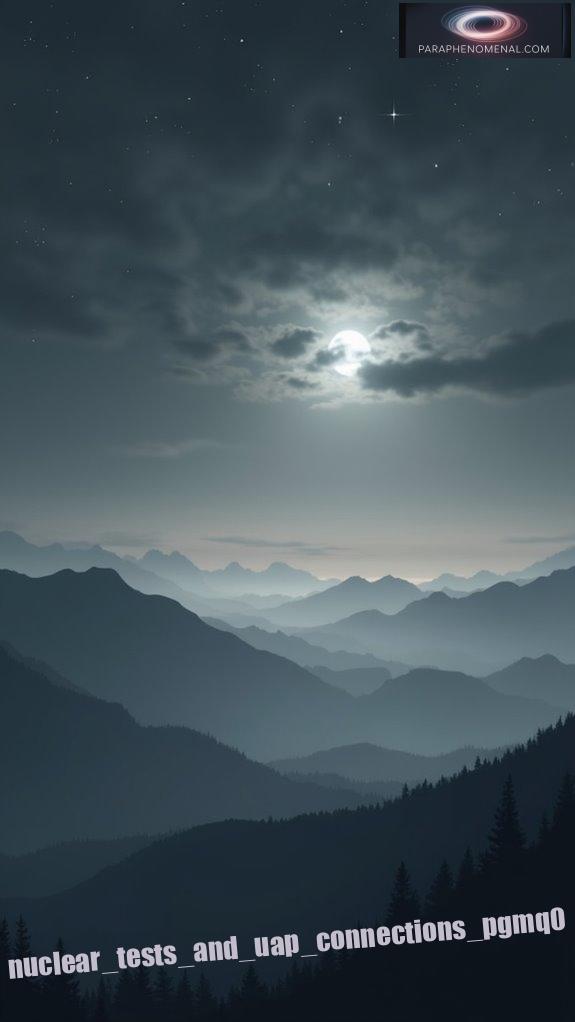What if I told you that the mysterious lights in our skies might share a hidden connection with history?
Well, POSS-I transients, spotted between 1949 and 1958, show a striking correlation with nuclear testing.
Reports of unidentified aerial phenomena (UAP) surged by 45% around these critical dates.
It’s fascinating to consider whether these nuclear tests triggered something otherworldly.
This intriguing possibility challenges our understanding of both UAPs and nuclear events, doesn’t it?
Isn’t it time we dive deeper into this common thread?
A Close Encounter with UFOs and Nuclear Testing
Years ago, while researching UFO sightings near military bases, I stumbled upon a riveting case involving an unusual bright light. Witnesses claimed it hovered ominously above a decommissioned nuclear site.
It made me recall the waves of UAP reports generated during the height of Cold War tensions. Could there be a connection?
With theories ranging from extraterrestrial visitors to government experiments, the intrigue only grows.
As I pieced together the puzzle, I couldn’t shake the feeling that we are on the edge of uncovering something monumental.
What if the answers lie within our nuclear past, waiting to be uncovered?
Quick Takeaways
- POSS-I transients appeared 45% more frequently around dates of nuclear tests, indicating a significant correlation.
- A p-value of 0.008 confirms the likelihood of a statistical relationship between transients and nuclear activities.
- Each additional UAP sighting was linked to an 8.5% increase in transient occurrences, suggesting an environmental interaction.
- The Short lifetimes of transients, under 50 minutes, and their rarity align with disturbances from nuclear testing effects.
- Environmental changes from nuclear testing may generate atmospheric disturbances, leading to increased transient observations and UAP reports.
Historical Context of the POSS-I Survey

While you may know the Palomar Observatory as a significant astronomical site, its POSS-I survey holds an intriguing spot in history. Conducted from 1949 to 1958, this survey aimed to usher in a new era of astronomical advancements. With nearly the entire northern sky photographed, it created a crucial archival resource. The project’s systematic approach and technical execution laid the groundwork for future studies in the field.
This survey’s historical significance can’t be overstated, as it provided an indispensable atlas for observing stars, galaxies, and transient phenomena. The POSS-I photographic plates became foundational references, enabling researchers worldwide to explore celestial mysteries freely.
At ParaPhenomenal, we dive deeper into these connections, highlighting their relevance to our understanding of the cosmos.
Statistical Correlations With Nuclear Testing
As you explore the links between POSS-I transients and nuclear testing, you may find it striking that these transients appeared more frequently around the dates of nuclear tests. In fact, transients were observed 45% more often within a day of detonations. This significant association, with a p-value of 0.008, confirms a non-random correlation. Additionally, the historical context of these occurrences aligns with reports of unidentified anomalous phenomena suggesting they could be influenced by nearby human activities.
Moreover, every nuclear test also saw a notable rise in UAP reports, with transient frequency increasing by 8.5% for each additional UAP sighted. The timing of these transients suggests a nuclear impact rather than mere coincidence or observational errors. Such compelling data fuels interest in understanding these mysterious phenomena. Transient star-like objects were identified during the first Palomar Observatory Sky Survey, adding another layer to their enigmatic nature.
At ParaPhenomenal, we aim to shed light on these extraordinary occurrences linked to human actions.
Observational Characteristics of Transients

POSS-I transients exhibit distinctive observational characteristics that set them apart from typical celestial objects. You’ll notice that these transients appear star-like and sharp on photographic plates, resembling real stars, while their short lifetimes—less than 50 minutes—are significant.
They’re often isolated, showing up sporadically during the survey period from 1949 to 1957, which hints at their statistical rarity.
Morphological analysis reveals that while some are genuine, others might be attributed to photographic artifacts. Curiously, transient occurrences shrink in Earth’s shadow, suggesting a relationship with solar illumination. Recent investigations suggest these transients may correlate with nuclear testing activities, further fueling interest in their origins.
Morphological analysis indicates a mix of genuine transients and potential photographic artifacts, hinting at intriguing connections to solar illumination.
This collection of features encourages a deeper investigation into potential links between these transients and historical events, which is why we created ParaPhenomenal—to explore such intriguing phenomena further.
Hypotheses Explaining the Link
The link between POSS-I transients and nuclear testing raises intriguing questions that scientists are keen to explore. Several theoretical frameworks shed light on potential connections.
The Nuclear Testing Hypothesis suggests that tests could generate atmospheric disturbances that manifest as transients. Another approach, the Anomalous Phenomena Hypothesis, speculates that UAP reports could be related to these events too.
Statistical associations support this, revealing a significant increase in transients following nuclear tests. Environmental influences might also play a role, with factors like meteor showers affecting observations. Studies on atmospheric disturbances provide evidence that nuclear testing could alter the environment in ways that trigger these transients.
Acknowledging these various hypotheses is essential for understanding the complex interplay of elements at work. Our interest in these connections drives us at ParaPhenomenal to investigate deeper into these unusual phenomena.
Implications for UAP Research

While researching UAPs, it’s essential to take into account how their association with nuclear testing influences various aspects of understanding these phenomena.
The historical backdrop of UAP reports reveals a striking correlation with nuclear testing, which can affect societal perceptions and reporting behaviors. By employing rigorous research methodologies and advanced statistical modeling, you can uncover patterns that might otherwise go unnoticed.
This multidisciplinary approach encourages collaboration across fields like psychology, sociology, and physics, enhancing data interpretation.
Moreover, raising public awareness about these links could reduce biases in UAP research, leading to more accurate and meaningful findings.
Platforms like ParaPhenomenal aim to facilitate these critical discussions and explore the implications of these connections for your understanding of UAPs.
Future Avenues for Investigation
Given the compelling statistical correlations between POSS-I transients and nuclear testing, it’s essential to explore future avenues of investigation that could deepen our understanding of these phenomena.
You can leverage advanced methodologies, such as time-windowed statistical models, to analyze the relationship between nuclear tests and UAP sightings more precisely.
Furthermore, interdisciplinary collaboration between physicists, astronomers, and military historians could shed light on potential physical mechanisms behind these transient events.
FAQ
How Were Transients Detected in the POSS-I Data?
Transients were detected in the POSS-I data through automated scans that flagged star-like point sources, missing from prior images.
Each candidate underwent cross-matching with modern surveys like Pan-STARRS and Gaia, ensuring no persistent counterpart. They faced classification challenges; some profiles mimicked real stars.
Machine learning models helped distinguish between true transients and spurious sources, while independent verification confirmed findings.
For those curious about unexplained events, we created ParaPhenomenal to explore these mysteries further.
What Specific Nuclear Tests Showed the Highest Correlations With Transients?
Nuclear events from the early 1950s, especially atmospheric tests, showed the highest correlations with transient identification.
Strikingly, the March 17, 1956 test marked the last link between transients and nuclear activity. You’ll notice that larger, publicized tests often led to more transient observations.
This connection hints at unknown atmospheric phenomena, prompting further investigation into what these transient flashes really are—a mystery we explore at ParaPhenomenal for those seeking freedom from ignorance.
Are There Other Astronomical Surveys Examining Similar Phenomena?
Yes, other astronomical surveys are investigating similar phenomena.
Multi-wavelength surveys like Pan-STARRS and ZTF analyze vast amounts of observational data, including archival data, to identify transient events.
These modern surveys have the ability to detect faster and fainter signals compared to older ones.
It’s essential to examine how these surveys correlate transient detections with historical nuclear test data, since this connection remains an area of intriguing research.
How Does Background Noise Affect Transient Observation Accuracy?
Visualize maneuvering through a dark forest, where every sound can distract you from finding the path.
That’s how background noise impacts transient observation accuracy. It diminishes transient reliability, making it harder to detect brief signals like whispers in the wind.
Noise filtering techniques become vital in this scenario, allowing you to sift through chaos and pinpoint important events.
Understanding this can enhance your observations, bringing clarity to what might otherwise remain hidden.
What Technology Was Used for the POSS-I Sky Survey?
The POSS-I sky survey utilized advanced observational techniques for its time, employing a 48-inch Palomar Schmidt telescope. It captured images on 14-inch Kodak photographic plates, covering significant portions of the sky.
This technology allowed astronomers to gather detailed information about celestial objects, enhancing our understanding of the universe.
Digitization of these images enables modern access to this crucial data, reflecting a commitment to scientific discovery and the freedom of exploration that inspires our work at ParaPhenomenal.
References
- https://sciety-labs.elifesciences.org/articles/by?article_doi=10.21203/rs.3.rs-6347224/v1
- https://www.iflscience.com/puzzling-transient-lights-in-the-1950s-skies-focused-around-nuclear-testing-facilities-intriguing-study-finds-81275
- https://phys.org/news/2025-10-mysterious-transient-sky-linked-nuclear.html
- https://www.nature.com/articles/s41598-025-21620-3
- https://www.ancient-origins.net/news-science-space/uap-nuclear-sites-00102254
- https://en.wikipedia.org/wiki/National_Geographic_Society_–_Palomar_Observatory_Sky_Survey
- https://greg.org/archive/2010/09/28/the-palomar-sky-survey-i-the-makers-of.html
- https://ned.ipac.caltech.edu/level5/March07/Reshetnikov/Reshetnikov3.html
- https://adsabs.harvard.edu/full/1991PASP..103..661R
- https://academic.oup.com/mnras/article-pdf/326/4/1279/3646619/326-4-1279.pdf
- https://www.sciencealert.com/study-links-mysterious-lights-in-the-sky-to-historic-nuclear-tests
- https://academic.oup.com/rasti/article/3/1/73/7601398
- https://www.iflscience.com/uap-researchers-search-for-transient-events-in-earths-shadow-finding-unexplained-events-80323
- https://evidencenetwork.ca/are-unidentified-objects-in-space-immortalized-between-1949-and-1957-linked-to-nuclear-tests/
- https://www.metabunk.org/threads/transients-in-the-palomar-observatory-sky-survey.14362/
- https://interestingengineering.com/space/ufo-reports-nuclear-weapons-tests-link
- https://ground.news/daily-briefing/studies-1950s-light-flashes-correlate-with-nuclear-tests-and-ufo-reports_478365
- https://arxiv.org/html/2507.15896v1
- https://academic.oup.com/mnras/article/515/1/1380/6607509
- https://newspaceeconomy.ca/2025/07/30/mysterious-sky-transients-potentially-tied-to-nuclear-tests-and-uap-reports/
- https://www.iflscience.com/disappearing-stars-in-the-1950s-associated-with-uaps-and-nuclear-weapons-tests-80181
- https://hearingreview.com/practice-building/practice-management/comparison-of-transient-noise-reduction-systems
- https://pmc.ncbi.nlm.nih.gov/articles/PMC8980828/
- https://www.nature.com/articles/s41467-019-10611-4
- https://pmc.ncbi.nlm.nih.gov/articles/PMC9743306/
- https://pubs.geoscienceworld.org/geophysics/article/88/5/E135/627215
- https://academic.oup.com/mnras/article/326/4/1279/1062871
- http://sundog.stsci.edu/first/apj/sectionstar3_3.html
- https://adsabs.harvard.edu/full/1997JBAA..107…88B
- https://www.astrofriend.eu/astronomy/science-data/poss1/poss1-data.html


















